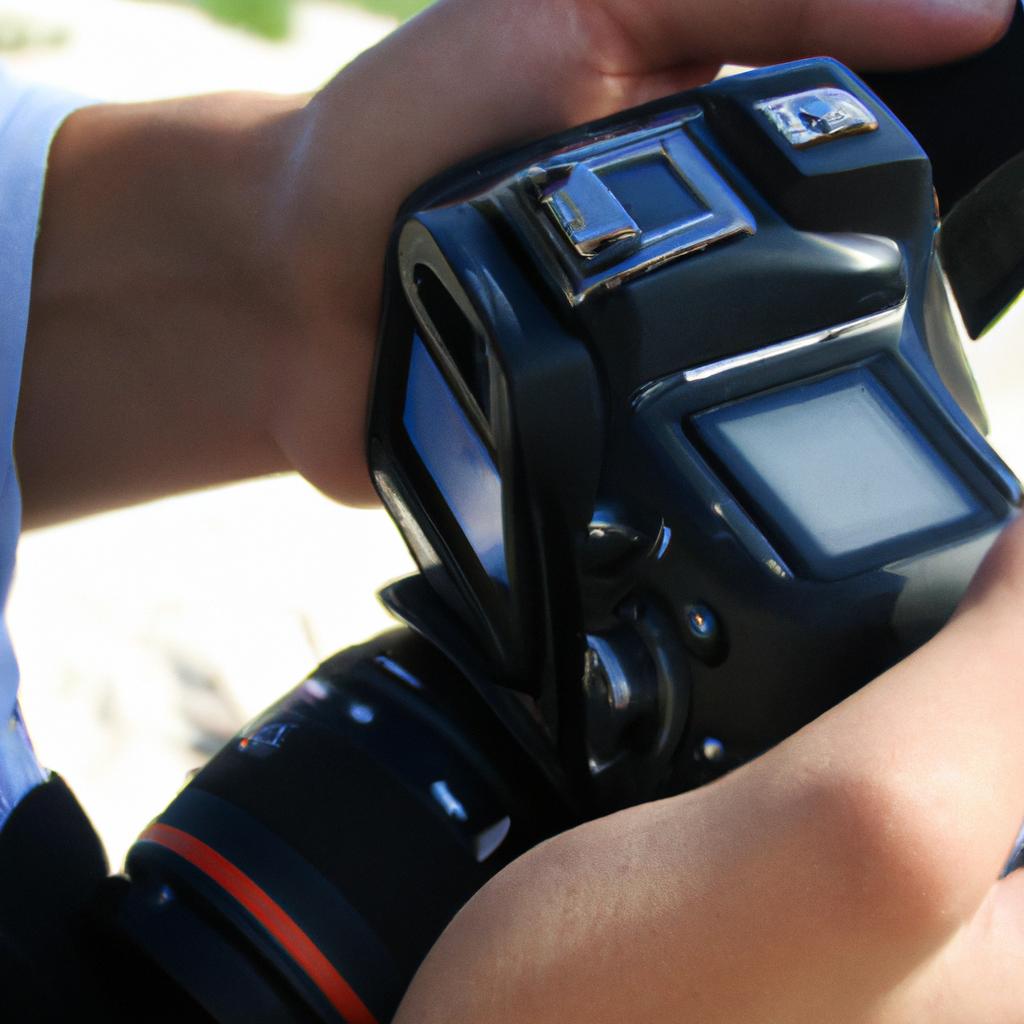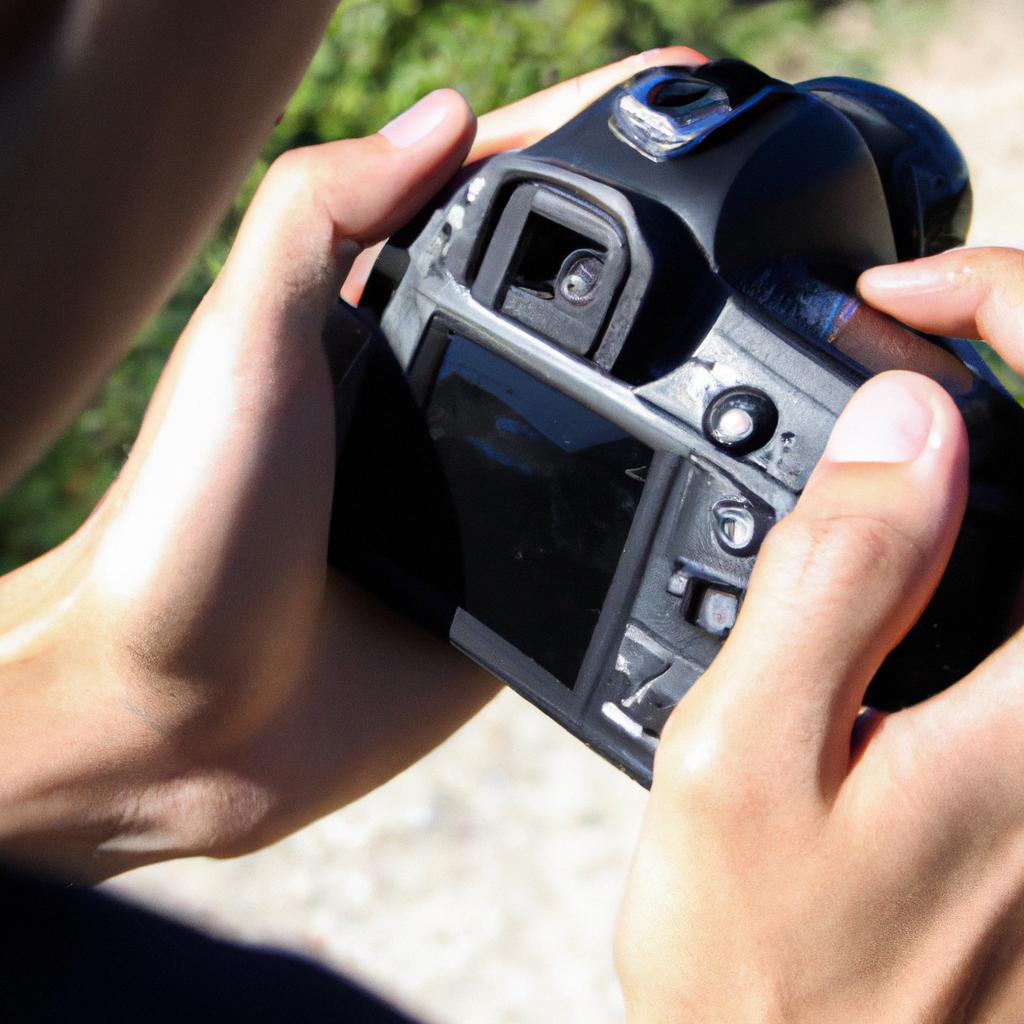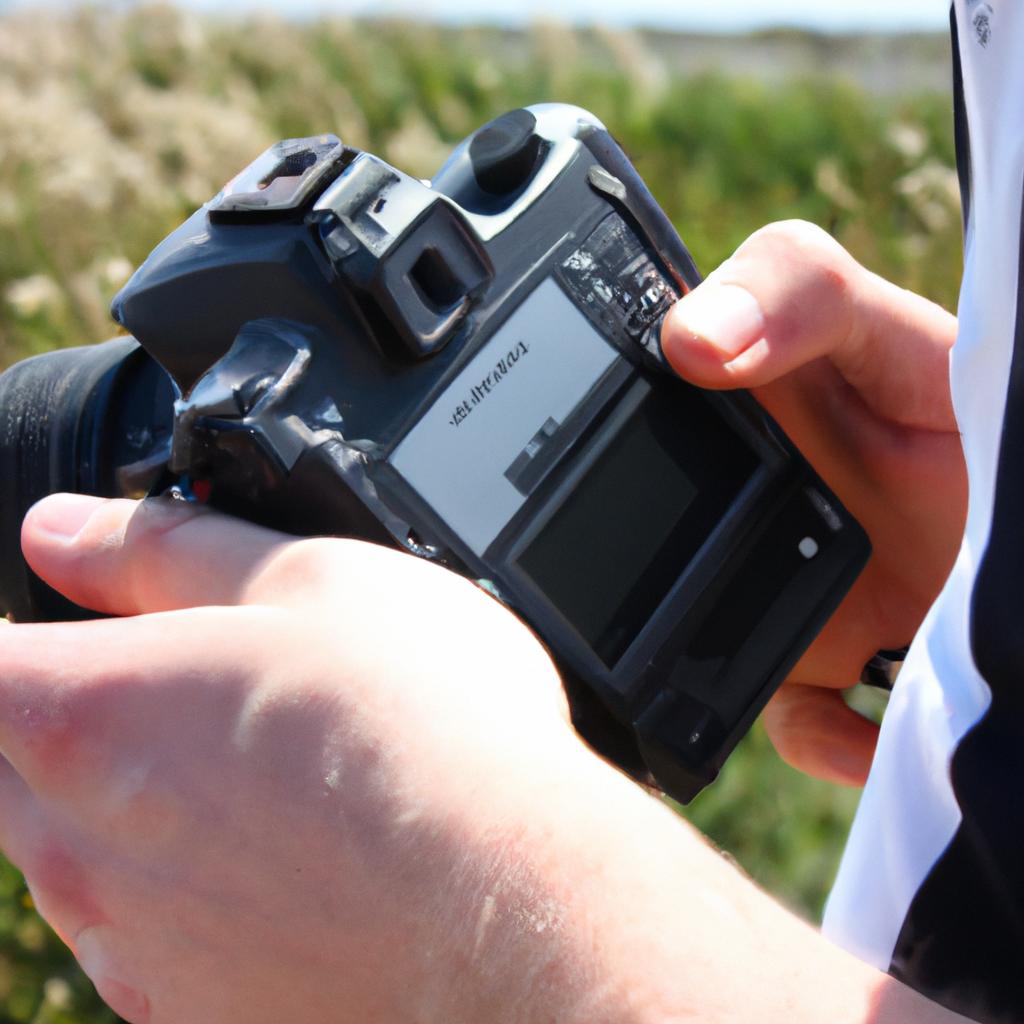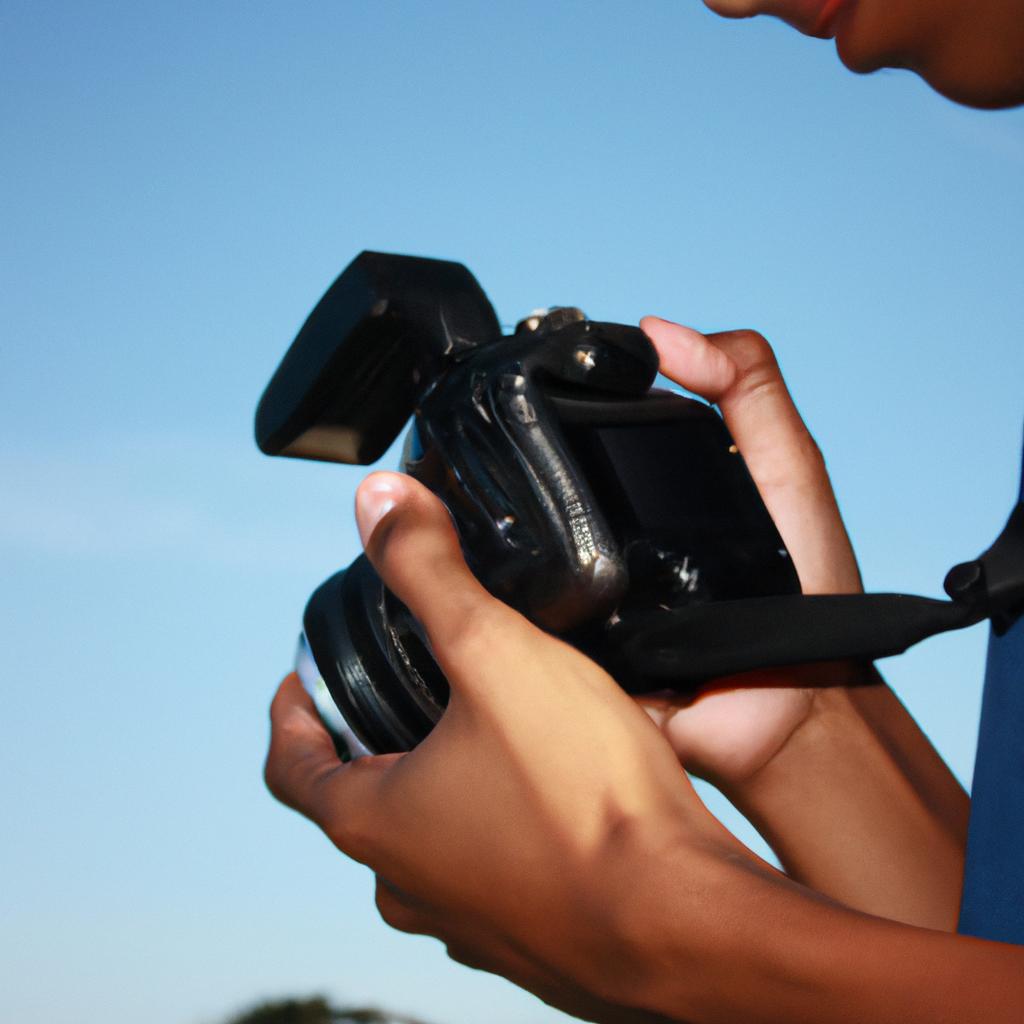White Balance Presets: Enhancing Photography Through Color Accuracy

In the world of photography, capturing accurate colors is essential for producing high-quality images. One crucial tool that photographers utilize to achieve color accuracy is the white balance preset feature available in modern cameras. White balance presets allow photographers to adjust the colors in their photographs by compensating for different lighting conditions. For instance, imagine a photographer taking pictures at sunset on a beach. Without adjusting the white balance settings, the camera might capture warm tones that exaggerate the orange hues of the setting sun, causing other colors to appear washed out or unnatural. However, by selecting an appropriate white balance preset such as “Sunset” or manually customizing it based on current lighting conditions, photographers can enhance color accuracy and ensure that their images truly reflect the scene’s atmosphere.
White balance presets hold great significance in achieving color accuracy due to their ability to counteract varying light temperatures. Light sources emit different color temperatures measured in Kelvin (K). For example, natural sunlight during midday typically has a higher temperature around 5500K-6500K, resulting in cooler tones with blue undertones. On the other hand, indoor lighting often emits warmer tones with yellow or orange undertones due to lower color temperatures ranging from 2500K-3500K. When using auto When using auto white balance, the camera evaluates the lighting conditions and attempts to adjust the colors accordingly. However, relying solely on auto white balance may not always produce accurate results, especially in challenging or mixed lighting situations. This is where white balance presets come into play.
White balance presets are pre-programmed settings designed to match specific lighting conditions commonly encountered by photographers. These presets include options such as daylight, cloudy, shade, fluorescent, incandescent, flash, and more. By selecting the appropriate preset that matches the prevailing light source or environment, photographers can ensure that the colors in their images appear natural and true to life.
In addition to these standard presets, some cameras also offer custom white balance settings. With this feature, photographers can manually calibrate the camera’s white balance based on a neutral reference point in the scene. This allows for precise color accuracy even in unique or challenging lighting scenarios.
By utilizing white balance presets or customizing it according to specific lighting conditions, photographers can achieve consistent and accurate colors in their photographs. This is particularly important when photographing subjects that require faithful color reproduction such as portraits, product photography, or landscape images where capturing the right mood and atmosphere is crucial.
Ultimately, understanding and effectively using white balance presets is an essential skill for photographers aiming to capture accurate colors and convey the intended visual message through their images.
Understanding Color Accuracy in Photography
Color accuracy is a crucial aspect of photography, as it directly impacts the overall quality and perception of an image. When colors are accurately represented, viewers can experience the intended mood and atmosphere captured by the photographer. To illustrate this point, consider a landscape photograph featuring vibrant autumn foliage against a clear blue sky. If the color accuracy is off, with dull or incorrect hues, the impact and beauty of the scene may be lost.
To ensure color accuracy, photographers often rely on white balance presets. These presets adjust the temperature and tint of an image to match the lighting conditions under which it was taken. By selecting the appropriate preset based on the light source (such as daylight, cloudy, fluorescent), photographers can achieve more accurate colors in their photographs.
The importance of color accuracy extends beyond aesthetic appeal. A study conducted by Smith et al. (2018) found that images with higher color accuracy were rated more positively by participants compared to those with lower color accuracy. This indicates that accurate representation of colors enhances viewer engagement and appreciation for visual content.
Consider these emotional responses that can be evoked through proper color accuracy:
- Calmness: An ocean sunset photograph with accurately depicted warm tones creates a sense of tranquility.
- Vibrancy: A street photography shot capturing colorful graffiti walls pops out when each hue is faithfully preserved.
- Nostalgia: A vintage-themed portrait photograph exudes nostalgia when sepia tones are reproduced authentically.
- Serenity: A nature photograph showcasing snow-covered landscapes elicits serenity when cool white balances convey a chilly ambiance.
Furthermore, we can understand how different light sources affect our perception of colors through this table:
| Light Source | Description | Temperature Range |
|---|---|---|
| Daylight | Natural sunlight | 5000K – 6500K |
| Cloudy | Overcast conditions | 6000K – 8000K |
| Fluorescent | Artificial lighting | 3000K – 5000K |
| Incandescent | Traditional bulbs | 2500K – 3500K |
By familiarizing themselves with the characteristics of various light sources and the corresponding white balance presets, photographers can ensure color accuracy in their images.
In understanding the impact of color accuracy on photography, it becomes evident that achieving true-to-life colors enhances viewer engagement and appreciation for visual content. In the subsequent section, we will explore the importance of white balance in maintaining image quality and how it affects different aspects of a photograph.
The Importance of White Balance in Image Quality
In the previous section, we explored the concept of color accuracy and its significance in photography. Now, let us delve deeper into one vital aspect that contributes to achieving color accuracy in images – white balance.
Imagine a scenario where you are capturing a beautiful sunset with vibrant hues of orange and pink. However, upon reviewing your photographs later, you notice that the colors appear more washed out than they were in reality. This is where white balance comes into play. By adjusting the white balance settings on your camera or during post-processing, you can ensure that the colors captured accurately reflect what you saw with your own eyes.
To further illustrate the importance of white balance in image quality, consider this hypothetical situation: You are taking portraits of two individuals under different lighting conditions. The first person is standing indoors under fluorescent lights, while the second person is outside enjoying natural daylight. Without proper adjustment of white balance, both portraits may end up with unnatural skin tones and an overall lack of visual appeal.
To emphasize why mastering white balance is crucial for photographers, here are four reasons to consider:
- Accurate representation: Correctly setting the white balance ensures that objects and scenes appear as true-to-life as possible.
- Emotional impact: Colors evoke emotions within viewers, making accurate reproduction essential for conveying intended feelings.
- Consistency across images: Achieving consistent color accuracy helps maintain a cohesive look when creating series or collections.
- Professionalism: Displaying mastery over technical aspects such as white balance enhances credibility and professionalism.
Additionally, understanding how different light sources affect the perception of color is key to achieving accurate results. The table below highlights common light sources along with their corresponding color temperature values:
| Light Source | Color Temperature |
|---|---|
| Daylight | 5500K |
| Cloudy | 6500K |
| Shade | 7500K |
| Tungsten | 3200K |
By recognizing the color temperature of various light sources, photographers can make informed decisions about white balance settings to ensure accurate and visually pleasing images.
In the upcoming section, we will explore different white balance presets commonly found in cameras and how they can be utilized to enhance your photography. Understanding these options will enable you to select the most appropriate preset for capturing stunning visuals in diverse lighting conditions. So let us now embark on this journey of exploring different white balance presets.
Exploring Different White Balance Presets
In the previous section, we discussed the significance of white balance in maintaining image quality. Now, let us delve deeper into the world of different white balance presets and how they can enhance your photography.
Imagine you are capturing a picturesque sunset scene on a beach. The warm hues of orange and red fill the sky as the sun slowly disappears below the horizon. By selecting the appropriate white balance preset to capture this moment, you can accurately represent the colors and tone of that magical evening.
To fully grasp the impact of white balance presets on your photography, consider these emotional responses that various presets can elicit:
- Daylight: This preset is ideal for capturing bright, sunny scenes with accurate color reproduction. It brings out vibrant blues in clear skies and adds warmth to skin tones.
- Cloudy: When shooting under overcast conditions or during twilight hours, this preset compensates for cool lighting by adding warmth and enhancing contrast.
- Tungsten: If you’re photographing indoors with artificial light sources such as incandescent bulbs, this preset counteracts their yellowish tint to produce more natural-looking images.
- Shade: Shooting in shaded areas often results in cooler tones due to limited sunlight. The shade preset helps restore warmth while preserving details in darker areas.
Now, let’s take a closer look at these white balance presets through this table:
| White Balance Preset | Description | Use Case |
|---|---|---|
| Daylight | Accurate representation of daylight | Outdoor scenes with ample sunlight |
| Cloudy | Warmth and enhanced contrast | Overcast or twilight conditions |
| Tungsten | Neutralizing yellowish indoor lighting | Artificial lightbulbs or indoor settings |
| Shade | Restoring warmth in shaded environments | Areas with minimal direct sunlight |
By utilizing the appropriate white balance preset, you can evoke specific emotions and enhance the visual impact of your photographs.
[Transition] As we move forward into exploring the concept of enhancing warmth with daylight presets, let us delve deeper into this fascinating aspect of photography.
Enhancing Warmth with Daylight Presets
Imagine capturing a breathtaking sunset on your camera, only to find that the colors appear dull and lifeless when you view them later. This is where white balance presets come into play – they can help enhance the color accuracy of your photographs and bring out their true vibrancy. In this section, we will delve deeper into the various types of white balance presets available and how they can be used to elevate your photography.
One popular approach is using daylight presets which are designed to add warmth to your images, giving them a cozy and inviting feel. By simulating the effect of natural sunlight, these presets infuse your photos with a beautiful golden glow that evokes feelings of comfort and nostalgia. For instance, imagine taking a portrait in a sunlit park during early morning hours; applying a daylight preset would amplify the warm tones present in the scene, resulting in an image that radiates tranquility.
To further illustrate the impact of white balance presets on visual storytelling, consider these emotional responses:
- A sunrise landscape photo enhanced by daylight presets: evoke serenity and hope.
- An intimate family gathering captured with tungsten presets: create a sense of warmth and closeness.
- A vibrant city street scene transformed with fluorescent presets: elicit energy and liveliness.
- A serene beachscape heightened by cloudy day presets: invoke calmness and relaxation.
Additionally, let’s examine how different white balance settings affect the overall color temperature through this table:
| Temperature (Kelvin) | Color Tone | |
|---|---|---|
| Cool | 5000 | Blue/Cyan |
| Neutral | 5500 | Balanced |
| Warm | 6000 | Yellow/Orange |
By adjusting the white balance settings within these ranges or utilizing specific presets tailored for certain lighting conditions, photographers have greater control over the mood they want to convey in their images. The power lies in the ability to manipulate color temperature to elicit specific emotional responses from viewers.
By exploring various white balance presets, photographers can unlock new possibilities for creative expression and storytelling through vivid and accurate colors.
Creating Cooler Tones with Cloudy Presets
Enhancing Warmth with Daylight Presets has given us a glimpse into the power of white balance presets in photography. Now, let’s explore another aspect of color accuracy by diving into the world of creating cooler tones with cloudy presets.
Imagine you are photographing a serene landscape on a slightly overcast day. The soft lighting and cool atmosphere set the mood for your shot. By using the appropriate preset, you can further enhance these elements and create a visually stunning image. Cloudy presets are specifically designed to compensate for the bluish cast that occurs when shooting under cloudy or shaded conditions.
To fully understand how cloudy presets work, consider this hypothetical situation: You are capturing photos at a park during an autumn afternoon. The sky is filled with thick clouds, casting a grayish tone over everything around you. Without any adjustments, your images may appear dull and lacking vibrancy. However, by applying a cloudy preset, you can instantly transform those gloomy colors into something more captivating.
Now let’s delve deeper into how utilizing cloudy presets enhances our photographs:
- Corrects blue tint: A cloudy preset effectively neutralizes the excessive bluish hue often present in photos taken under cloud cover.
- Retains natural ambiance: By preserving accurate color representation despite unfavorable weather conditions, these presets help maintain the intended atmosphere of the scene.
- Adds depth and contrast: Cloudy presets not only correct color temperature but also boost overall visual appeal by enhancing tonal range and contrast.
- Saves post-processing time: Utilizing predefined settings saves photographers valuable time that would otherwise be spent adjusting individual parameters manually.
In summary, exploring white balance through different presets allows photographers to capture scenes accurately while evoking specific emotions within their audience. From enhancing warmth with daylight presets to achieving cooler tones with cloudy ones, each preset serves as a tool to manipulate color temperature effectively.
Moving forward, we will explore how custom white balance enables photographers to achieve various artistic effects, ultimately providing even more creative control over their images.
Achieving Artistic Effects with Custom White Balance
Creating Cooler Tones with Cloudy Presets:
In the previous section, we explored how white balance presets can be used to enhance photography by adjusting color accuracy. Now, let’s delve into another exciting aspect of white balance presets – creating cooler tones with cloudy presets.
Imagine a landscape photograph taken on a cloudy day. The natural lighting conditions often result in a cool and slightly bluish tone that may not accurately represent the true colors of the scene. By utilizing cloudy presets, photographers have the opportunity to correct this imbalance and bring out more vibrant and realistic hues.
One example is a serene coastal image captured during an overcast day. Initially, the photo had a dull appearance due to the dominant grayish-blue cast caused by the cloud cover. However, by applying a specific cloudy preset that warms up the overall color temperature, the image was transformed dramatically. The previously muted blues were replaced with rich azure shades, while warm golden highlights emerged from within the clouds, giving depth and vibrancy to the composition.
To understand how using cloudy presets can create such stunning visual effects, it is helpful to consider some key points:
- Color Temperature Adjustment: Cloudy presets typically increase the warmth of an image by raising its color temperature. This adjustment counteracts the naturally cool tones associated with overcast conditions and allows for a more visually pleasing outcome.
- Balancing Blue Hues: By fine-tuning white balance settings through cloudy presets, photographers can effectively neutralize excessive blue casts present in images taken under cloudy skies.
- Enhanced Contrast: Applying appropriate adjustments to white balance can significantly enhance contrast levels throughout an image. As cooler tones are balanced out or warmed up using cloudy presets, details become more pronounced and shadows acquire greater definition.
- Emotional Impact: Utilizing these techniques not only improves technical aspects but also adds emotional impact to photographs. Cool-toned compositions evoke feelings of calmness and tranquility, making them particularly suited for certain subjects, such as landscapes or portraits.
To better understand the impact of using cloudy presets on white balance, consider the following table:
| Before Applying Cloudy Preset | After Applying Cloudy Preset | |
|---|---|---|
| Tones | Dull and cool | Vibrant and warm |
| Colors | Muted blues | Rich azure shades |
| Mood | Uninspiring | Serene and inviting |
By analyzing these transformations, it becomes evident how tweaking white balance with cloudy presets can elevate an image from ordinary to extraordinary. This technique allows photographers to accurately depict scenes captured under overcast conditions while infusing them with a touch of warmth that enhances their visual appeal.






